Blockchain Layer 0,1,2,3


In the context of cryptocurrencies and blockchain technology, the term "layer" refers to different levels of infrastructure and protocols that serve distinct purposes within the ecosystem. These layers work together to create a functional, scalable, and interoperable blockchain network. Here’s an overview of the different layers in the crypto space:
Layer 0
Layer 0 provides the foundational infrastructure that enables communication and interoperability between different blockchain networks. It serves as the underlying protocol upon which multiple blockchains (Layer 1) can be built and interact.
Key Features:
Interoperability: Facilitates communication between disparate blockchains.
Scalability: Supports multiple blockchain networks to improve overall system performance.
Security: Provides a secure base for higher layers.
Examples:
Polkadot (DOT): Uses a relay chain to connect various blockchains (parachains).
Cosmos (ATOM): Utilizes the Inter-Blockchain Communication (IBC) protocol for cross-chain interactions.
Avalanche (AVAX): Supports subnets, which are custom blockchain networks that operate within the Avalanche ecosystem.
Layer 1
Layer 1 refers to the base blockchain network itself. This layer includes the protocol, consensus mechanism, and architecture that defines the blockchain's functionality.
Key Features:
Consensus Mechanism: Determines how transactions are validated (e.g., Proof of Work, Proof of Stake).
Security: Ensures the integrity and security of the blockchain.
Smart Contracts: Enables decentralized applications (DApps) to be built directly on the blockchain.
Examples:
Bitcoin (BTC): The first and most well-known blockchain network, using Proof of Work.
Ethereum (ETH): Supports smart contracts and DApps, transitioning from Proof of Work to Proof of Stake.
Cardano (ADA): Uses the Ouroboros Proof of Stake consensus mechanism.
Layer 2
Layer 2 solutions are built on top of Layer 1 blockchains to improve scalability, speed, and efficiency. They address issues like high transaction fees and slow confirmation times by handling transactions off the main blockchain while still leveraging its security.
Key Features:
Scalability: Increases transaction throughput without overloading the base layer.
Low Fees: Reduces transaction costs by processing transactions off-chain.
Speed: Improves transaction speed and finality.
Examples:
Lightning Network (for Bitcoin): Enables faster and cheaper transactions by creating off-chain payment channels.
Polygon (MATIC): Provides a framework for building and connecting Layer 2 scaling solutions to Ethereum.
Optimism (OP): Uses Optimistic Rollups to enhance Ethereum’s scalability.
Layer 3
Layer 3 focuses on the application layer, where decentralized applications (DApps) and user interfaces reside. This layer leverages the functionalities provided by Layer 1 and Layer 2 to deliver services directly to end-users.
Key Features:
DApps: Decentralized applications that provide various services (e.g., DeFi, gaming, social media).
User Interfaces: Tools and interfaces that make blockchain technology accessible to users.
Interoperability: Often relies on Layer 0 and Layer 2 solutions for seamless operation across multiple blockchains.
Examples:
Chainlink (LINK): Decentralized oracles that connect smart contracts with real-world data.
The Graph (GRT): Indexing protocol for querying blockchain data.
Synthetix (SNX): Platform for creating and trading synthetic assets.
Summary
Layer 0: Provides foundational infrastructure and interoperability for multiple blockchains.
Layer 1: The base blockchain network with its own protocol and consensus mechanism.
Layer 2: Solutions that enhance the scalability and efficiency of Layer 1 blockchains.
Layer 3: Application layer where DApps and user interfaces operate, utilizing lower layers for functionality and interoperability.
These layers work together to create a comprehensive blockchain ecosystem, each serving a distinct role to ensure the system's overall functionality, scalability, and usability.
